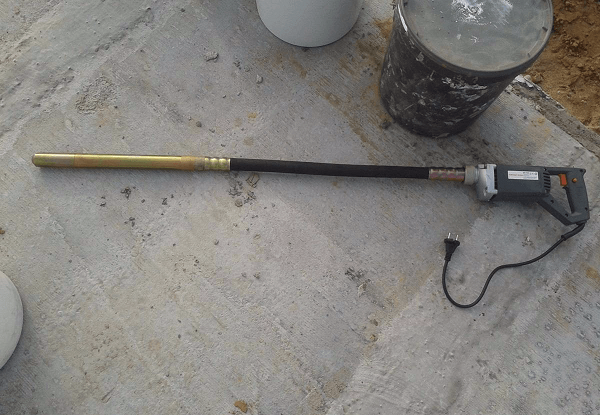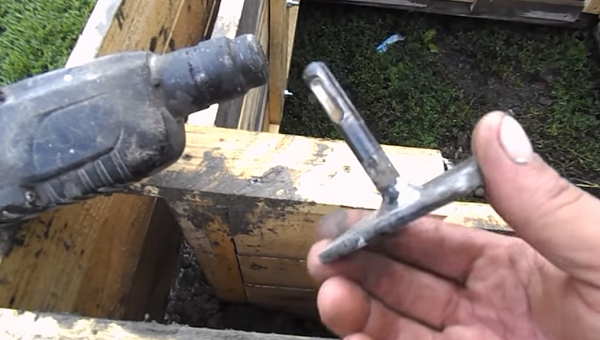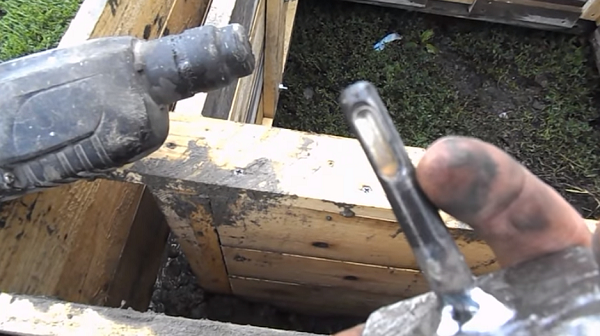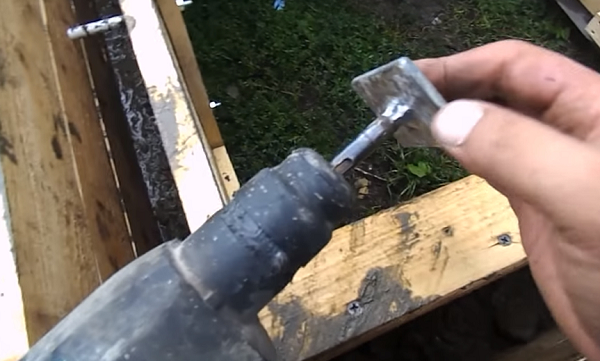Homemade punch: a vibrator for concrete and hole
During the pouring of the concrete solution, each layer is compacted. This is done manually by punching the mixture stacked in layers with rods of different materials (metal, wood). You can do all the work much faster with the help of special tools - vibrators. But the factory plate, purchased for home use, is not always an economically viable option, because it is expensive. To work for her several times, and after leaving to just lay there, it makes no sense. In this case, you can make a vibrator for concrete from a perforator with your own hands. Homemade will accelerate the process of ramming and improve the quality of work.
Content
Puncher vibrator
To implement the project in practice, you will need the following materials and tools:
- metal (steel) plate of the required dimensions, thickness from 50 to 70 mm;
- an iron rod or reinforcement (rectangular or circular cross-section) of such a length so that you can reach the bottom of the exposed formwork structure when pouring concrete;
- perforator;
- old bur or peak, paddle, chisel, even a crown;
- Bulgarian with discs for metal;
- welding machine with electrodes;
- ruler or tape measure;
- marker.

The minimum power of the punch should be 1.5 kW - only such a tool will provide the required performance without overheating.
One side of the rod section of 15-20 mm is treated so that it can be inserted into the punch chuck. A stainless steel plate is welded to the second side. For this you need special electrodes.
It is better that the rod also be from of stainless steel. Concrete is an aggressive environment. Ordinary metal is largely exposed to chemicals, and also mechanically wears faster.
The sequence of manufacturing nozzles for ramming is as follows:
- the rectangle of the required size is cut off by the grinder from the steel sheet, and a piece of the desired length from a round or rectangular rod;
- weld the plate to either end of the rod;

- cut off a seat of the drill with a small stock;

- weld it to the rod.

If you do not use the old drill, you will need to make a special adapter for the drill chuck, or with the help of machine-tool equipment to carve a seat at the free end of the rod. It is easiest to immediately use the drill of the desired length. On the base of the perforator, more complex devices can be made, for example, with a flexible shaft, which will additionally mix the working solution.
Homemade tamper for concrete of small size (the simplest version of production) is presented in the video.
Yamobur
Owners of dachas or private houses often face the necessity of digging holes for fence posts or pile supports. For drilling the earth is used as a hand tool, and equipped with an electric or fuel-driven (for example, gasoline). In the first case, the work will take a longer time, and will also require large labor costs. Buying or renting powerful devices is expensive, so craftsmen figured out how to make a homemade hole from a perforator.
But home-made devices, in comparison with factory analogues, have following cons:
- they can drill only relatively shallow holes of small diameter;
- for work on hard soils, they are not suitable.
Structurally, homemade devices consist of three parts:
- perforator;
- ordinary earthen auger;
- adapter or gearbox.
The last 2 details of the device can be made by hand. Even for sale special nozzle (auger) for drillingwhich fastens to the powerful perforator or a drill. The working tool made in this way is shown in the photo below.

The important point is the amount of power and the number of revolutions of the punch, which will be used in conjunction with the device for drilling. The optimal value of the first parameter for the manual model of homemade hole is 2 kW. It should be taken into account that, depending on the number of revolutions, the drill can be connected directly to the punch chuck or through a gearbox. For models with a capacity of 2 kW, the latter is not needed.
Optimal for drilling is the number of revolutions of the working nozzle from 60 to 300 per minute. This value depends on the properties of the soil on the site.
Drilling is performed in two ways:
- continuous;
- with periodic soil delivery.
In the first case, you will need a more powerful tool (with greater torque).
Algorithm for making a homemade drill
To make a drill for the pits with your own hands, you will need, besides a perforator, such tools and materials:
- angle grinder;
- welding machine with the appropriate electrode mark;
- electric drill;
- unnecessary punch drill;
- metal fittings or rod for the manufacture of rods;
- material for the cutting part;
- cable and sockets to make a simple extension cord.
The job of reworking a perforator into a device that can be used to drill holes in the ground is directly in the creation of nozzles. All work is performed in the following sequence:
- cut a piece of the required length from a rod or tube using a grinder (about a meter is enough if the power of the tool is 2 kW);
- knives are attached to the lower end (connection methods and design features of the cutting part are discussed below);
- cut off from the drill its base, intended for the installation of this nozzle into the perforator cartridge;
- weld the cut piece to the tube.
The simplest option is ready to use at work. If you do not use the base from the old punch drill, then you will need to grind out the seat for the tool cartridge or the adapter used.
In addition to the manual model, you can make semblance of a stationary drilling rigA possible version of which is presented in the photo below.

In order to provide power for a homemade hole, you will need to purchase or make an extension cord yourself.
Work created by the device is shown in the video.
Manufacturing cutting
As knives used:
- disks from circular saws of suitable diameter;
- ready-made augers from the factory motor drills or agricultural machinery;
- metal sheet, from which the circles of the required diameter are cut out, sharpening them and arching them as necessary.
The cutting part can be made removable (with a bolt connection method) or fixed (welded to the rod). Both options are presented in the photos below.


Cutting design must meet the following parameters:
- to have a larger diameter (enough for 5 mm) than this parameter in the created holes;
- it is necessary that the angle between the blades is equal to 25-30 degrees;
- The front (cutting) part of the knives should be sharpened at an angle of 45 ° -60 °.
It is desirable to make the tip of the drill out of a drill designed for drilling metal so that the tool can more easily enter the ground mass.
At its core, reworking a perforator into a vibrator or an earth auger consists in making a nozzle that is appropriate in terms of functionality and size. Difficulties can arise only if you prepare a seat for a cartridge or an adapter on the rods yourself. In general, the manufacture of the options considered does not require much time and effort.

/rating_on.png)
/rating_off.png)











